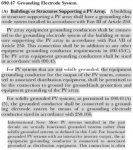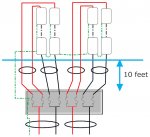ryangittens
Member
- Location
- usa
(D) Additional Auxiliary Electrodes for Array
Grounding. A grounding electrode shall be installed in
accordance with 250.52 and 250.54 at the location of all
ground- and pole-mounted PV arrays and as close as
practicable to the location of roof-mounted PV arrays.
The electrodes shall be connected directly to the array
frame(s) or structure. The dc grounding electrode
conductor shall be sized according to 250.166. Additional
electrodes are not permitted to be used as a substitute for
equipment bonding or equipment grounding conductor
requirements. The structure of a ground- or pole-mounted
PV array shall be permitted to be considered a grounding electrode if it meets the requirements of 250.52. Roofmounted
PV arrays shall be permitted to use the metal
frame of a building or structure if the requirements of
250.52(A)(2) are met.
Exception No. 1: An array grounding electrode(s) shall
not be required where the load served by the array is
integral with the array.
Exception No. 2: An additional array grounding
electrode(s) shall not be required if located within 1.8 m
(6 ft) of the premises wiring electrode.
Thanks for this! I don't know why I didn't start using this forum sooner.
I've seen plans rejected because the array didn't have a GEC so I'll just refrain from running it through the sub-panel.
One follow up, if the subpanel was being used a service disconnect that is "suitable for use as service equipment," would the neutral be bonded there and the GEC run from that point?
For what it's worth, we just went on the 2014 NEC equivalent here, and a couple months in I've yet to be asked to add a GEC. I do have a couple jurisdictions who have been insisting on a #8 GEC from the array for some time, but they've always let me combine it with the EGC and not have to run two wires.
Unless your array #8 GEC is run in a raceway or armored cable it should be #6.
690.46 Array Equipment Grounding Conductors. For PV modules, equipment grounding conductors smaller than 6 AWG shall comply with 250.120(C).
250.120(C) Equipment Grounding Conductors Smaller Than 6 AWG. Where not routed with circuit conductors as permitted in 250.130(C) and 250.134(B) Exception No. 2, equipment grounding conductors smaller than 6 AWG shall be protected from physical damage by an identified raceway or cable armor unless installed within hollow spaces of the framing members of buildings or structures and where not subject to physical damage.
Ground mounted arrays need a grounding electrode system for the structure.
What counts as "the structure"? Does every electromechanically continuous group of arrays count as an individual structure, which thus would need a dedicated grounding electrode?
Or do you just need a master grounding electrode system at the main service equipment for the entire group of structures?


Ground mounted arrays need a grounding electrode system for the structure.
These are all theories.
A structure can = an array or a building (fact).
Unfortunately, an array is defined as "mechanically integrated modules(panels)" (which is from the definition of array), but it seems like an array can also be electrically "integrated" (continuous?) or both (electromechanically?).
However, electromechanical isn't a term in the code.
So the answer to your 2nd question might be yes, which doesn't seem right for ungrounded (functionally grounded?) PV systems.
For ungrounded systems, the answer to your 3rd question might be yes. (Pretty sure it is?)
View attachment 16905
View attachment 16906
But...what about that grey part/note that spans the two pics above?
Unless your array #8 GEC is run in a raceway or armored cable it should be #6.
690.46 Array Equipment Grounding Conductors. For PV modules, equipment grounding conductors smaller than 6 AWG shall comply with 250.120(C).
250.120(C) Equipment Grounding Conductors Smaller Than 6 AWG. Where not routed with circuit conductors as permitted in 250.130(C) and 250.134(B) Exception No. 2, equipment grounding conductors smaller than 6 AWG shall be protected from physical damage by an identified raceway or cable armor unless installed within hollow spaces of the framing members of buildings or structures and where not subject to physical damage.
What counts as "the structure"? Does every electromechanically continuous group of arrays count as an individual structure, which thus would need a dedicated grounding electrode?
Or do you just need a master grounding electrode system at the main service equipment for the entire group of structures?
From article 100:
"Structure. That which is built or constructed."
Hope that helps.
Either you didn't read my question, or you deliberately gave a vague answer as a joke. ...
What I mean by "electromechanically continuous" is a shortcut term, meaning both electrically and mechanically continuous. In the case of a continuous row system, each row is electrically and mechanically continuous by the racking system through the structural members and fasteners, but is not mechanically continuous to the other rows. And is only electrically continous with neighboring rows, if you install a bonding jumper underground. Most cases it ultimately will be electrically continuous, through the EGC system.
There is also the case of a discrete "table" mounting system, where each group of modules (possibly 20) is not mechanically continuous across the breaks, and would have rack-to-rack bonding jumpers for electrical continuity.

We run everything from the roof in conduit.
I was reffering to the run from the last box to the array
From article 100:
"Structure. That which is built or constructed."
The 2017 added the phrase "other than equipment" to the definition
It seems like electrical connections would matter more than mechanical for safety/proper function of inverters.
However, one thing can be both. In this linked pic, I'd say the rails between the rows are both mechanical "integration" and the EGC.
The rows are mechanically and electrically continuous because of the rails.
http://34.194.54.245/wp-content/uploads/2015/12/Eagle_Point_Dubuque_Municipal_Building.jpg
In this next pic below, say there are no rails between rows, so the dotted green line is the bonding jumper underground between rows you mentioned.
Seems fine this way- but... if the rows are *not* mechanically integrated (no rails), we're supposed to run an EGC from every row to the combiner, because the conductors are "leaving the vicinity of the array".
That seems weird, if all 4 strings are going to the same inverter which has 1 EGC connection point, why would you want more than 1 EGC?
(Also- if the disconnect has to be 10 feet from the array, isn't that 10 foot point "within the vicinity" of the array? Please?)
View attachment 16910

